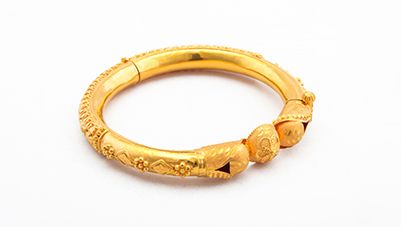Rs. 5,000 - Rs. 2 crore
To find the nearest gold loan branch,
Enter phone and OTP | Check amount you can get | Apply for quick funds
How does 21K gold differ from other gold purities?
21K gold mainly differs from other purities because of the amount of real gold it contains. It has 87.5% pure gold, which places it between 18K (75%) and 22K (91.6%). It also has a richer yellow colour than 18K and is slightly stronger than 22K, making it a good choice for jewellery that you want to wear regularly. Since it is less soft than 24K gold, it holds its shape better and is less likely to get bent or damaged. Overall, 21K gold gives you a great mix of purity, strength, and a beautiful warm gold tone.
How to identify 21K gold jewellery?
You can identify 21K gold jewellery by checking for the right hallmarks. Look for stamps like “21K” or “875”, which confirm its purity. These marks are usually placed on the inner side of rings, behind earrings, or on necklace clasps. The colour also gives a clue—21K gold has a deeper yellow tone than 18K but is slightly lighter than 22K. If you want full confirmation, a jeweller can test it using an electronic tester, acid test, or XRF machine. Always buy from trusted sellers who provide proper certification.
What does 21K gold mean in jewellery and investments?
In jewellery, 21K gold offers a nice balance of purity and durability. It gives you a rich yellow finish but is strong enough for everyday wear. This makes it popular for heavier jewellery, traditional pieces, and designs that need both beauty and strength. From an investment point of view, 21K gold holds good value because of its high gold content. It is easier to sell or trade in regions where it is commonly used, such as parts of Asia and the Middle East. Because it is strong and keeps its shine for years, many people consider it a smart long-term choice.
What are the top benefits of 21K gold?
The biggest advantage of 21K gold is that it balances purity and durability very well. It has a lovely deep yellow shine that looks close to pure gold, yet it is stronger than 22K or 24K, so it handles everyday wear better. It is also more resistant to scratches and tarnishing, helping it stay bright for a long time. For investors, its higher gold content makes it more valuable than 18K jewellery. Since 21K gold is accepted in many global markets, it is easy to sell, exchange, or pass down as a long-term asset.
Wondering how much you can borrow on your gold? Just check your gold loan eligibility—it takes seconds and minimal paperwork!
The significance of 21K in gold stamps and hallmarks
When you see a “21K” or “875” on gold jewellery is a hallmark that signifies the piece is made of 21 karat gold, which is 87.5% pure. This stamp is an important indicator of quality and authenticity, ensuring that buyers and sellers are aware of the exact gold content in the jewellery. Hallmarks, including the "21K" stamp, are typically mandated by law in many countries to protect consumers from fraud and to guarantee the integrity of the gold. In addition to the karat stamp, jewellery may also feature the manufacturer's mark and a symbol representing the assay office that certified the piece. These hallmarks collectively offer assurance of the gold's quality and purity. For investors and collectors, the 21K stamp adds value by confirming the gold's authenticity, making it easier to appraise, sell, or trade the jewellery in various markets.
How to calculate the price of 21k gold?
Calculating the price of 21K gold involves understanding the current market price of gold per gram and then adjusting it for the purity of 21K gold. Begin by finding the daily gold rate, typically quoted for 24K gold. Since 21K gold is 87.5% pure, multiply the 24K gold price per gram by 0.875 to get the 21K gold price per gram. For example, if the 24K gold price is ₹5,000 per gram, the price for 21K gold would be ₹4,375 per gram. To calculate the total cost of a piece of 21K gold jewellery, multiply the weight of the jewellery in grams by the 21K gold price per gram. If the jewellery includes additional elements like gemstones, their cost will be added separately. Also, remember to include making charges and applicable taxes such as GST to determine the final price.
How to check 21 karat gold purity?
Checking the purity of 21 karat gold involves looking for hallmark stamps that indicate the gold content. Typically, 21K gold will be stamped with “21K” or “875”, signifying its 87.5% purity. This hallmark is an assurance of quality and authenticity. Additionally, the colour of 21K gold is distinct, possessing a deep, rich yellow tone that is slightly darker than 22K gold but not as intense as 18K gold. A more precise method to check 21 carat gold purity is through acid testing, where a small scratch is made on the gold and a specific acid is applied to see how it reacts. Electronic gold testers and X-ray fluorescence (XRF) analysis are also used by jewellers to confirm the exact gold content without damaging the piece. Always ensure you buy 21K gold from reputable sellers who provide a purity certificate.
As gold prices change with global trends, knowing your borrowing capacity can help you stay prepared. Check your gold loan eligibility to know how much you can borrow today.
How to maintain 21K gold jewellery?
Keeping your 21K jewellery in good shape is simple. Clean it now and then with mild soap and warm water, gently brushing away dirt or oil. Dry it completely with a soft cloth. Avoid harsh chemicals, perfumes, and lotions, as they can dull the shine. When not wearing your jewellery, store it in a soft pouch or a lined box so it does not rub against other pieces. If you wear it often, getting it polished by a jeweller once in a while keeps it shining like new.
Care and maintenance of 21K gold jewellery
Proper care and maintenance of 21K gold jewellery are essential to preserving its beauty and longevity. Start by cleaning your jewellery regularly using warm water and mild soap, ensuring you rinse and dry it thoroughly to avoid water spots. Avoid exposing 21K gold to harsh chemicals like chlorine, which can weaken the metal over time. It’s also important to remove jewellery before engaging in activities that could lead to scratches or damage, such as sports or heavy lifting. Store your 21K gold pieces in a soft cloth or padded jewellery box to prevent them from scratching against other items. Regular inspections by a jeweller can help identify any wear or damage early, allowing for timely repairs. By following these care tips, you can ensure that your 21K gold jewellery retains its shine and continues to be a cherished possession.
Understanding ounce before applying for a gold loan
Understanding the concept of an ounce is crucial before applying for a gold loan, as gold prices are often quoted per ounce in the global market. The standard unit used is the troy ounce, which is equivalent to approximately 31.1035 grams. When considering a gold loan, knowing the current market price of gold per ounce allows you to accurately estimate the value of your gold. This knowledge is essential for negotiating the loan amount, as lenders typically offer a percentage of the gold's current market value. Ensure you keep track of gold price fluctuations, as these can impact the loan-to-value ratio offered by the lender. In India, gold is more commonly weighed in grams, so understanding the conversion between ounces and grams will help you make informed decisions when applying for a gold loan.
Turn your gold into instant support—handle any expense with ease. Check your gold loan eligibility and access funds when you need them most.
Related Articles
Disclaimer
Bajaj Finance Limited has the sole and absolute discretion, without assigning any reason to accept or reject any application. Terms and conditions apply*.
For customer support, call Personal Loan IVR: 7757 000 000









 Personal Loan
Personal Loan Check Eligibility
Check Eligibility Salaried Personal Loan
Salaried Personal Loan EMI Calculator
EMI Calculator Account Aggregator
Account Aggregator Credit Pulse Report
Credit Pulse Report
 Deals starting @99
Deals starting @99 Min. 50% off
Min. 50% off
 Bajaj Pay
Bajaj Pay Wallet to Bank
Wallet to Bank
 Easy EMI Loan
Easy EMI Loan Savings Offer
Savings Offer Smartphones
Smartphones Led TVs
Led TVs Washing Machines
Washing Machines Laptops
Laptops Refrigerators
Refrigerators Air Conditioner
Air Conditioner Air Coolers
Air Coolers
 Loan Against Shares
Loan Against Shares Loan Against Mutual Funds
Loan Against Mutual Funds Loan Against Insurance Policy
Loan Against Insurance Policy ESOP Financing
ESOP Financing Easy EMI Loan
Easy EMI Loan Two-wheeler Loan
Two-wheeler Loan Loan for Lawyer
Loan for Lawyer Industrial Equipment Finance
Industrial Equipment Finance Industrial Equipment Balance Transfer
Industrial Equipment Balance Transfer Industrial Equipment Refinance
Industrial Equipment Refinance Personal Loan Branch Locator
Personal Loan Branch Locator Used Tractor Loan
Used Tractor Loan Loan Against Tractor
Loan Against Tractor Tractor Loan Balance Transfer
Tractor Loan Balance Transfer Flexi
Flexi View All
View All
 Two-wheeler Loan
Two-wheeler Loan Bike
Bike Scooter
Scooter Electric Vehicle
Electric Vehicle Best Sellers
Best Sellers Popular Brands
Popular Brands

 Trading Account
Trading Account Open Demat Account
Open Demat Account Margin Trading Financing
Margin Trading Financing Share Market
Share Market Invest in IPO
Invest in IPO All stocks
All stocks Top gainers
Top gainers Top losers
Top losers 52 week high
52 week high 52 week low
52 week low Loan against shares
Loan against shares
 Home Loan
Home Loan Transfer your existing Home loan
Transfer your existing Home loan Loan against Property
Loan against Property Home Loan for Salaried
Home Loan for Salaried Home loan for self employed
Home loan for self employed Loan Against Property Balance Transfer
Loan Against Property Balance Transfer Home Loan EMI Calculator
Home Loan EMI Calculator Home Loan eligibility calculator
Home Loan eligibility calculator Home Loan balance transfer
Home Loan balance transfer View All
View All
 Term Life Insurance
Term Life Insurance ULIP Plan
ULIP Plan Savings Plan
Savings Plan Family Insurance
Family Insurance Senior Citizen Health Insurance
Senior Citizen Health Insurance Critical Illness Insurance
Critical Illness Insurance Child Health Insurance
Child Health Insurance Pregnancy and Maternity Health Insurance
Pregnancy and Maternity Health Insurance Individual Health Insurance
Individual Health Insurance Low Income Health Insurance
Low Income Health Insurance Student Health Insurance
Student Health Insurance Group Health Insurance
Group Health Insurance Retirement Plans
Retirement Plans Child Plans
Child Plans Investment Plans
Investment Plans
 Business Loan
Business Loan Secured Business Loan
Secured Business Loan Loan against property
Loan against property Loans against property balance transfer
Loans against property balance transfer Loan against shares
Loan against shares Home Loan
Home Loan Loans against mutual funds
Loans against mutual funds Loan against bonds
Loan against bonds Loan against insurance policy
Loan against insurance policy
 Apply for Gold Loan
Apply for Gold Loan Transfer your Gold Loan with Us
Transfer your Gold Loan with Us Gold Loan Branch Locator
Gold Loan Branch Locator
 ULIP Plan
ULIP Plan Savings Plan
Savings Plan Retirement Plans
Retirement Plans Child Plans
Child Plans Free Demat Account
Free Demat Account Invest in Stocks
Invest in Stocks Invest in IPO
Invest in IPO Margin Trading Facility
Margin Trading Facility Fixed Deposit Branch Locator
Fixed Deposit Branch Locator
 Check your Credit Score
Check your Credit Score
 New Car Loan
New Car Loan Used Car Loan
Used Car Loan Loan Against Car
Loan Against Car Car Loan Balance Transfer and Top-up
Car Loan Balance Transfer and Top-up My Garage
My Garage
 Get Bajaj Prime
Get Bajaj Prime
 Mobiles on EMI
Mobiles on EMI Electronics on EMI Offer
Electronics on EMI Offer  Iphone on EMI
Iphone on EMI LED TV on EMI
LED TV on EMI Refrigerator on EMI
Refrigerator on EMI Laptop on EMI
Laptop on EMI Kitchen appliances on EMI
Kitchen appliances on EMI Washing machines
Washing machines
 Personal Loan EMI Calculator
Personal Loan EMI Calculator Personal Loan Eligibility Calculator
Personal Loan Eligibility Calculator Home Loan EMI Calculator
Home Loan EMI Calculator Home Loan Eligibility Calculator
Home Loan Eligibility Calculator Good & Service Tax (GST) Calculator
Good & Service Tax (GST) Calculator Flexi Day Wise Interest Calculator
Flexi Day Wise Interest Calculator Flexi Transaction Calculator
Flexi Transaction Calculator Secured Business Loan Eligibility Calculator
Secured Business Loan Eligibility Calculator Fixed Deposits Interest Calculator
Fixed Deposits Interest Calculator Two wheeler Loan EMI Calculator
Two wheeler Loan EMI Calculator New Car Loan EMI Calculator
New Car Loan EMI Calculator Used Car Loan EMI Calculator
Used Car Loan EMI Calculator All Calculator
All Calculator Used Tractor Loan EMI Calculator
Used Tractor Loan EMI Calculator
 Hot Deals
Hot Deals Clearance Sale
Clearance Sale Kitchen Appliances
Kitchen Appliances Tyres
Tyres Camera & Accessories
Camera & Accessories Mattresses
Mattresses Furniture
Furniture Watches
Watches Music & Audio
Music & Audio Cycles
Cycles Mixer & Grinder
Mixer & Grinder Luggage & Travel
Luggage & Travel Fitness Equipment
Fitness Equipment Fans
Fans
 Personal Loan for Doctors
Personal Loan for Doctors Business loan for Doctors
Business loan for Doctors Home Loan
Home Loan Secured Business Loan
Secured Business Loan Loan against property
Loan against property Secured Business Loan Balance Transfer
Secured Business Loan Balance Transfer Loan against share
Loan against share Gold Loan
Gold Loan Medical Equipment Finance
Medical Equipment Finance
 Smart Hub
Smart Hub ITR Service
ITR Service Digi Sarkar
Digi Sarkar
 Savings Offer
Savings Offer Easy EMI
Easy EMI Offer World
Offer World 1 EMI OFF
1 EMI OFF New Launches
New Launches Zero Down Payment
Zero Down Payment Clearance Sale
Clearance Sale Bajaj Mall Sale
Bajaj Mall Sale
 Mobiles under ₹20,000
Mobiles under ₹20,000 Mobiles under ₹25,000
Mobiles under ₹25,000 Mobiles under ₹30,000
Mobiles under ₹30,000 Mobiles under ₹35,000
Mobiles under ₹35,000 Mobiles under ₹40,000
Mobiles under ₹40,000 Mobiles under ₹50,000
Mobiles under ₹50,000
 Articles
Articles
 Overdue Payments
Overdue Payments Other Payments
Other Payments
 Document Center
Document Center Bank details & Documents
Bank details & Documents Tax Invoice Certificate
Tax Invoice Certificate
 Do Not Call Service
Do Not Call Service
 Hamara Mall Orders
Hamara Mall Orders

 Fixed Deposit (IFA) Partner
Fixed Deposit (IFA) Partner Loan (DSA) Partner
Loan (DSA) Partner Debt Management Partner
Debt Management Partner EMI Network Partner
EMI Network Partner Became a Merchant
Became a Merchant Partner Sign-in
Partner Sign-in
 Trade directly with your Demat A/c
Trade directly with your Demat A/c ITR
ITR My Garage
My Garage
 Live Videos - Beta
Live Videos - Beta
 Savings Offer
Savings Offer Smartphones
Smartphones LED TVs
LED TVs Washing Machines
Washing Machines Laptops
Laptops Refrigerators
Refrigerators Air Conditioners
Air Conditioners Air Coolers
Air Coolers Water Purifiers
Water Purifiers Tablets
Tablets Kitchen Appliances
Kitchen Appliances Mattresses
Mattresses Furniture
Furniture Music and Audio
Music and Audio Cameras & Accessories
Cameras & Accessories Cycle
Cycle Watches
Watches Tyres
Tyres Luggage & Travel
Luggage & Travel Fitness Equipment
Fitness Equipment Tractor
Tractor Easy EMI Loan
Easy EMI Loan
 vivo Mobiles
vivo Mobiles OPPO Mobiles
OPPO Mobiles Xiaomi Mobiles
Xiaomi Mobiles Sony LED TVs
Sony LED TVs Samsung LED TVs
Samsung LED TVs LG LED TVs
LG LED TVs Haier LED TVs
Haier LED TVs Godrej Refrigerators
Godrej Refrigerators Voltas Washing Machines
Voltas Washing Machines
 New Tractor Loan
New Tractor Loan Used Tractor Loan
Used Tractor Loan Loan Against Tractor
Loan Against Tractor Tractor Loan Balance Transfer
Tractor Loan Balance Transfer
 New Car Loan
New Car Loan New Cars Under ₹10 Lakh
New Cars Under ₹10 Lakh New Cars – ₹10–₹15 Lakh
New Cars – ₹10–₹15 Lakh New Cars – ₹15–₹20 Lakh
New Cars – ₹15–₹20 Lakh New Cars – ₹20–₹25 Lakh
New Cars – ₹20–₹25 Lakh New Car Brands
New Car Brands Petrol – New Cars
Petrol – New Cars Diesel – New Cars
Diesel – New Cars Electric – New Cars
Electric – New Cars CNG – New Cars
CNG – New Cars Hybrid – New Cars
Hybrid – New Cars









